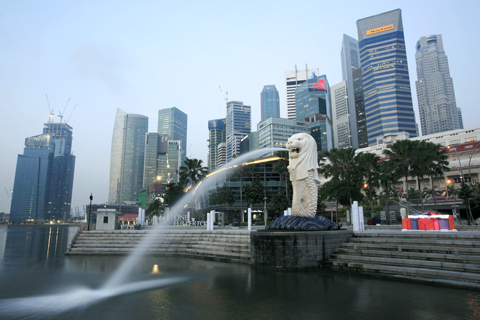Singapore’s economy grew at its fastest rate in at least 35 years in the first three months of this year, bouncing back from a contraction the previous quarter as manufacturing activity more than doubled.
GDP grew at an annualized, seasonally adjusted, 32.1 percent in the first quarter from the previous quarter, the biggest leap since quarterly results began in 1975, the Trade and Industry Ministry said yesterday.
The economy grew 13.1 percent in the first quarter from the same period a year ago and the government boosted its GDP forecast for this year to between 7 percent and 9 percent from between 4.5 percent and 6.5 percent, the ministry said.

PHOTO: REUTERS
“The recovery of the Singapore economy has been stronger than expected and more entrenched since the beginning of this year,” the central bank said. “Looking ahead, domestic economic activity is likely to be sustained at a relatively high level.”
Singapore’s strong GDP numbers suggest demand from the US is recovering and Asia has emerged from last year’s recession as a leading driver of global growth.
The city-state was the first Asian country to report first-quarter GDP results, while China is scheduled to do so today.
Industrial production jumped 139 percent from the previous quarter, led by electronics and biomedical industries, while the service sector grew 11 percent, the ministry said.
Singapore’s economy relies on trade, finance and tourism.
The preliminary first quarter GDP results were based mostly on data from January and February, and may be revised when the government announces complete results next month, the ministry said.
The central bank, known as the Monetary Authority of Singapore, said yesterday after a twice-a-year policy review that it had shifted its exchange rate target from a zero percent appreciation of the Singapore dollar to a “modest and gradual” appreciation in a bid to dampen inflation.
“The move is fully justified, not only by the enormous strength of Q1 GDP, but the likely sustainability of the recovery,” said Robert Prior-Wandesforde, senior Asia analyst for HSBC.
“The Asian recovery has become self-sustaining,” Prior-Wandesforde said.
The government also raised its inflation forecast for this year by 0.5 percentage points to between 2.5 percent and 3.5 percent.
“Inflationary pressures are likely to pick up, driven by rising global commodity prices,” the central bank said after its policy review meeting.

Authorities have detained three former Taiwan Semiconductor Manufacturing Co (TMSC, 台積電) employees on suspicion of compromising classified technology used in making 2-nanometer chips, the Taiwan High Prosecutors’ Office said yesterday. Prosecutors are holding a former TSMC engineer surnamed Chen (陳) and two recently sacked TSMC engineers, including one person surnamed Wu (吳) in detention with restricted communication, following an investigation launched on July 25, a statement said. The announcement came a day after Nikkei Asia reported on the technology theft in an exclusive story, saying TSMC had fired two workers for contravening data rules on advanced chipmaking technology. Two-nanometer wafers are the most

NEW GEAR: On top of the new Tien Kung IV air defense missiles, the military is expected to place orders for a new combat vehicle next year for delivery in 2028 Mass production of Tien Kung IV (Sky Bow IV) missiles is expected to start next year, with plans to order 122 pods, the Ministry of National Defense’s (MND) latest list of regulated military material showed. The document said that the armed forces would obtain 46 pods of the air defense missiles next year and 76 pods the year after that. The Tien Kung IV is designed to intercept cruise missiles and ballistic missiles to an altitude of 70km, compared with the 60km maximum altitude achieved by the Missile Segment Enhancement variant of PAC-3 systems. A defense source said yesterday that the number of

A bipartisan group of US representatives have introduced a draft US-Taiwan Defense Innovation Partnership bill, aimed at accelerating defense technology collaboration between Taiwan and the US in response to ongoing aggression by the Chinese Communist Party (CCP). The bill was introduced by US representatives Zach Nunn and Jill Tokuda, with US House Select Committee on the Chinese Communist Party Chairman John Moolenaar and US Representative Ashley Hinson joining as original cosponsors, a news release issued by Tokuda’s office on Thursday said. The draft bill “directs the US Department of Defense to work directly with Taiwan’s Ministry of National Defense through their respective

Tsunami waves were possible in three areas of Kamchatka in Russia’s Far East, the Russian Ministry for Emergency Services said yesterday after a magnitude 7.0 earthquake hit the nearby Kuril Islands. “The expected wave heights are low, but you must still move away from the shore,” the ministry said on the Telegram messaging app, after the latest seismic activity in the area. However, the Pacific Tsunami Warning System in Hawaii said there was no tsunami warning after the quake. The Russian tsunami alert was later canceled. Overnight, the Krasheninnikov volcano in Kamchatka erupted for the first time in 600 years, Russia’s RIA